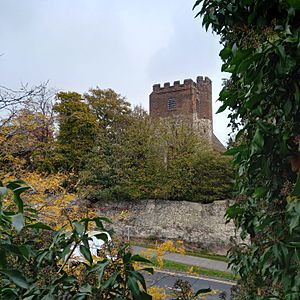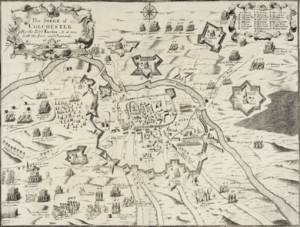Siege of Colchester facts for kids
Quick facts for kids Siege of Colchester |
|||||||
|---|---|---|---|---|---|---|---|
| Part of Second English Civil War | |||||||
 St Mary-at-the-Walls church was used as a gun battery during the siege. You can still see the brick repairs to the tower. |
|||||||
|
|||||||
| Belligerents | |||||||
| Commanders and leaders | |||||||
| Earl of Norwich Lord Capel Sir Charles Lucas Sir George Lisle |
Sir Thomas Fairfax | ||||||
| Strength | |||||||
| 4,000 | 5,000 (plus reinforcements) | ||||||
| Casualties and losses | |||||||
| 1,000 | 500-1,000 | ||||||
The Siege of Colchester happened in the summer of 1648. This was during the Second English Civil War, a time when fighting broke out again in many parts of Britain. The town of Colchester became a key battleground. A Royalist army, loyal to the King, was marching through East Anglia to gather support. But they were attacked by a Parliamentary army, led by Lord-General Thomas Fairfax.
The Parliamentarians' first attack forced the Royalist army to hide behind Colchester's town walls. However, Fairfax's forces couldn't win quickly. So, they began a long siege. Even though conditions were terrible, the Royalists held out for eleven weeks. They only gave up after the Royalist army in the North of England was defeated at the Battle of Preston (1648).
Contents
Why the Siege Happened
The Start of the Rebellion
On May 21, 1648, people in the county of Kent started a rebellion against Parliament. Lord-General Fairfax led the Parliamentary forces to Maidstone and took the town back on June 1. The remaining Royalist soldiers, led by the Earl of Norwich, escaped from Kent. They planned to join the rebellion in Essex.
On June 5, a group of people supporting Parliament in Chelmsford, Essex, were captured by an angry crowd. Colonel Henry Farre and some local soldiers from the Essex Trained Bands announced they supported the King. Charles Lucas took charge of the Essex soldiers. On June 9, he was joined by the Earl of Norwich, Lord Capel, Lord Loughborough, George Lisle, and about 500 Royalist soldiers from Kent.
Royalists March to Colchester
The next day, Lucas marched with about 4,000 soldiers to Braintree. This was where the county's weapons were stored. However, Thomas Honywood, a member of the Essex Parliament committee, had already secured the weapons. He did this with the help of northern Essex soldiers who stayed loyal to Parliament.
Lucas then continued to Colchester, arriving on June 12. He wanted to gather more soldiers there. His plan was to then move on to Suffolk and Norfolk. He hoped to get those counties to support the King as well.
Fairfax Prepares for Battle
Fairfax and his Parliamentary forces from Kent joined the Essex forces under Thomas Honywood outside Colchester on June 13. Colonel John Barkstead's infantry (foot soldiers) from London also arrived. In total, Fairfax now had over 5,000 experienced soldiers and more than 1,000 cavalry (horse soldiers). He decided to use the same plan he had used in Maidstone: launch a quick, full-scale attack.
The Battle for Colchester

The Royalists set up their defenses on the edge of town, on Maldon Road. This was where the Parliamentary army was coming from. The battle was very fierce. Barkstead's foot soldiers attacked three times but were pushed back. The Royalists were well protected behind the hedges along the road.
Finally, the Parliamentary cavalry, who had many more horses than the Royalists, surrounded the Royalist sides. This forced the Royalist foot soldiers to retreat behind the town walls. Barkstead's men followed them through the gates. But then, a well-planned counter-attack by Royalist foot and horse soldiers pushed them back out.
Fairfax kept attacking. It wasn't until midnight that he finally stopped. He had to accept that he couldn't take the town quickly. In this battle, he lost between 500 and 1,000 men. The Royalists reported losing 30 men and two officers. However, this number is likely much lower than their actual losses.
The Siege Begins
When the siege started, both armies had about the same number of men. Both also expected more soldiers to arrive. Lord Norwich was talking with men from Suffolk, hoping they would join him. He also knew that the Scots and Langdale's Royalist army in the North were fighting for the King. The Earl of Holland, who led Royalist forces in the South, was trying to gather a rescue army. Fairfax, on the other hand, expected parts of the New Model Army to join him when they could.
Fairfax's first goal was to stop anyone from outside helping the town. He also wanted to prevent the trapped Royalists from leaving. He ordered forts to be built around the town and placed his siege cannons to fire at the walls. His soldiers were spread thin, but soon more arrived. Six companies of horse and dragoons (soldiers who rode horses but fought on foot) joined him. Also, the Suffolk Trained Bands, whom Norwich had hoped would join the Royalists, instead joined Parliament.
The Suffolk men mostly wanted to stop either side from causing damage in their county. So, Fairfax gave them the job of guarding the bridges over the River Colne to the north and east. Parliamentary ships were ordered to block the harbor and river mouth. This was to stop any supplies from reaching the town by water.
Life Inside the Town
Inside Colchester, the local people were trapped with an army they mostly didn't support. Colchester had strongly supported Parliament during the First English Civil War. Any sympathy for the Royalist army quickly disappeared as the soldiers took food and supplies from the townspeople.
By July 2, the town was completely surrounded. This made it very hard for the trapped soldiers to leave and find food. On July 5, Lucas, with 400 cavalry, and Lisle, with 600 foot soldiers, attacked the Suffolk Trained Band guarding the East Gate. The Suffolk men were surprised and ran away. However, the Royalists went too far from the town. They were then attacked by Parliament's forces and lost many men. They also lost the cannons and supplies they had taken.
On the night of July 14, Fairfax ordered an attack on Royalist forts outside the town walls. St John's Abbey and Charles Lucas's house were captured after fierce fighting. The Royalist defenses at St Mary's church were completely destroyed by cannon fire. This also destroyed the Royalists' main cannon battery.
Attempts to Break Out
After clearing the town's outer areas, Fairfax sent a messenger on July 16. He offered the Royalists inside the town a chance to surrender. Lucas's reply was a threat: if the messenger came again with such a message, he would be executed.
By this time, Lord Norwich had heard that the Earl of Holland would not be able to rescue them. A part of the New Model Army, led by Colonel Adrian Scroope, had defeated the Earl of Holland in a night attack at St Neots. On July 15, the Royalist cavalry, about 1,000 strong, tried to break out of Colchester. But they were stopped near Boxted. A series of fights, known as the Battle of Boxted Heath, lasted for a couple of days. It ended with the Royalists retreating back into Colchester on the 18th. Another attempt by two cavalry groups to escape on the night of July 18 also failed. However, on July 22, Bernard Gascoigne and his remaining cavalry managed to escape from Colchester using the Maldon road. They fought hard against Parliamentary forces and went into Cambridgeshire, where they split up.
Even though the Royalists still had 3,000 soldiers, Fairfax's position was too strong. With almost daily reinforcements, his forces totaled at least 6,000. Still, Lord Norwich hoped his army would eventually be rescued. He received a letter from Langdale, the Northern Royalist army leader. The letter encouraged the Essex men and promised help within two weeks. For Lord Norwich, it seemed there was still a reason to keep fighting.
Running Out of Food
By August, food in Colchester had almost completely run out. Cats, dogs, and horses became the main food. Fairfax refused to let the townspeople leave or even let supplies in. This was despite many requests from outside the town, pleas from the Colchester Town council, and even from Lord Norwich. Fairfax made this decision even though the town had been loyal to Parliament during the First Civil War.
Things became so desperate that the people of Colchester were forced to eat soap and candles. When the townswomen and children tried to beg for food at the town gates, the soldiers surrounding the town turned them away with nothing. In a final plea for kindness, the Royalist commanders sent 500 starving women to the Parliamentary lines. They hoped the women might get food by making the soldiers feel sorry for them.
The End of the Siege
On August 24, Fairfax received news of Cromwell’s victory at the Battle of Preston. To celebrate, the Parliamentary cannons fired salutes. Fairfax also had kites flown into the town carrying news that the Royalist army had been destroyed. That same day, talks began to end the siege.
Fairfax would not listen to any terms from Lord Norwich. Instead, he offered his own terms, which could not be changed. These terms were that common soldiers and junior officers would be treated fairly. However, senior officers had to surrender without any guarantees about how they would be treated.
On the morning of August 28, the Royalist army gave up their weapons. The gates were opened, and the winning Parliamentary soldiers entered the town with Lord-General Fairfax leading them. The terms of surrender were:
- The Lords and Gentlemen were all prisoners, meaning their fate would be decided later.
- The common soldiers were disarmed and given passes to go home. They had to promise not to fight against Parliament again.
- The town would not be looted if it paid £14,000 in cash.
What Happened Next
The important Royalist leaders, Lord Norwich, Lord Capel, and Lord Loughborough, had their future decided by Parliament. Lord Capel was executed for serious disloyalty. Lord Norwich and Lord Loughborough were sent away from the country.
A military court found Lucas, Lisle, Farre, and Gascoigne guilty of serious disloyalty and sentenced them to death. This punishment was rare during the Civil Wars. But Fairfax and Ireton said it was fair for several reasons. They claimed Lucas had executed Parliamentary prisoners without mercy. They also said he had broken his promise after the First Civil War. And they argued that the Royalists had kept fighting in a position that couldn't be defended, causing unnecessary deaths and suffering. A clear reason for executing these leaders was to show that Parliament was now fully in control. It also showed that any further attempts to fight would be dealt with quickly.
During the night, Farre managed to escape. It was also discovered that Gascoigne was an Italian citizen, so he was spared from being shot. However, by Fairfax's order, Lucas and Lisle were executed on the evening of August 28. Within days, pamphlets (small books) were made, praising Lucas and Lisle as heroes for the King's cause. Today, there is a monument in the grounds of Colchester Castle marking the place where they were executed.



